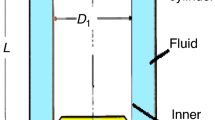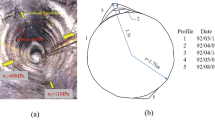Abstract
The rheological properties of drilling fluids have been always considered as critical aspects to the success of drilling operations; in this fact, the control of these properties was of paramount importance. In this paper, the rheological behaviour of a water-soluble polymer, namely hydroxyethyl cellulose (HEC) used in drilling fluids, was investigated. Steady-state shear rheology and frequency experiment were carried out on the sample at different concentrations ranging from 0.1 to 1.2 wt% and constant temperature of 25 ± 0.1 °C using a controlled-rate rheometer. The HEC solutions showed a shear thinning behaviour that was successfully fitted using the Cross model, where its parameters were found to increase with the HEC concentration. The steady-state shear rheological data allowed determining the intrinsic viscosity of the polymer (~ 15.05 dl/g) in distilled water; thereafter, an estimation of the molecular weight of HEC using the Mark–Houwink equation indicated that the studied sample was of high molecular weight (9.5 × 105 g/mol), which gave it good rheological properties for drilling fluid applications. The critical overlap concentration was found to be ~ 0.24 wt% using two methods, the intrinsic viscosity and the plot of the apparent viscosity versus the polymer concentration at specific shear rate. The frequency sweep measurements allowed confirming the viscoelastic behaviour of the polymer; HEC solutions behaved either as viscous or as elastic materials at low and high frequencies, respectively. This information is essential for mud engineers to develop and maintain the properties of drilling fluid to the required specifications.







Similar content being viewed by others
Abbreviations
- a :
-
Mark–Houwink constant
- \( C \) :
-
Concentration (%)
- C* :
-
Overlap concentration (%)
- C** :
-
Second critical concentration (%)
- \( C. \left[ \eta \right] \) :
-
Overlap parameter
- CMC:
-
Carboxymethyl cellulose
- G′:
-
Storage modulus (Pa)
- G′′:
-
Loss modulus (Pa)
- HEC:
-
Hydroxyethyl cellulose
- hmHEC:
-
hydrophobically modified hydroxyethyl cellulose
- \( k \) :
-
Constant of the Mark–Houwink relationship (dl/g)
- \( k^{{\prime }} \) :
-
Huggins constant
- \( k^{{{\prime \prime }}} \) :
-
Constant
- \( M \) :
-
Molecular weight (g/mol)
- \( n \) :
-
Dimensionless constant
- W :
-
Frequency (rad/s)
- \( \dot{\gamma } \) :
-
Shear rate (s−1)
- \( \lambda \) :
-
Time constant (s)
- \( \eta \) :
-
Viscosity of the polymer solution (Pa s)
- \( \eta_{\text{s}} \) :
-
Viscosity of the solvent (Pa s)
- \( \eta_{0 } \) :
-
Zero shear rate viscosity (Pa s)
- \( \eta_{\infty } \) :
-
Infinite shear rate viscosity (Pa s)
- \( \left[ \eta \right] \) :
-
Intrinsic viscosity (cm3/g)
- \( \eta_{\text{app}} \) :
-
Apparent viscosity (Pa.s)
- \( \eta_{\text{inh}} \) :
-
Inherent viscosity (cm3/g)
- \( \eta_{\text{r}} \) :
-
Relative viscosity
- \( \eta_{\text{red}} \) :
-
Reduced viscosity (cm3/g)
- \( \eta_{\text{sp}} \) :
-
Specific viscosity
References
Beheshti N, Nguyen GTM, Kjøniksen A-L, Knudsen KD, Nyström B (2006) Structure and dynamics of aqueous mixtures of an anionic cellulose derivative and anionic or cationic surfactants. Colloids Surf A Physicochem Eng Asp 279:40–49
Brown W, Henley D, Öhman J (1963) Studies on cellulose derivatives. Part II. The influence of solvent and temperature on the configuration and hydrodynamic behaviour of Hydroxyethyl cellulose in dilute solution. Makromol Chem 64:49–67
Bueche F (1962) Physical properties of polymers. Interscience, New York
Carico RD, Bagshaw FR (1978) Description and use of polymers used in drilling, work-overs and completions. Paper SPE 7747 presented at the SPE production technology symposium, Hobbs, NM
Castelain C, Doublier JL, Lefebvre J (1987) A study of the viscosity of cellulose derivatives in aqueous solutions. Carbohyd Polym 7:1–16
Chatterji J, Borchardt JK (1981) Applications of water-soluble polymers in the oil field. JPT 2042–2056
Clasen C, Kulicke W-M (2001) Determination of viscoelastic and rheo-optical material function of water-soluble cellulose derivatives. Prog Polym Sci 26:1839–1919
Cole RC, Ali SA, Foley KA (1995) A new environmentally safe crosslinked polymer for fluid-loss control. Paper SPE 29525 presented at the SPE production operations symposium, Oklahoma City
Cornett JE (1977) Polymer-Brine mud speeds austim well. Petroleum Engineer
Cross MM (1965) Rheology of non-Newtonian fluids: a new flow equation for pseudoplastic systems. J Colloid Sci 20:417–437
Ferry JD (1970) Viscoelastic properties of polymers. Wiley, New York
Graessley WW (1974) The entanglement concept in polymer rheology. Advances in polymer science, vol 16. Springer, Berlin
Graessley WW (1980) Polymer chain dimensions and the dependence of viscoelastic properties on concentration, molecular weight and solvent power. Polymer 21:258–262
Grigorescu G, Kuliche W-M (2000) Prediction of viscoe1astic properties and shear stability of polymers in solution. Adv Polym Sci 152:1–40
Harding SE (1997) The intrinsic viscosity of biological macromolecules, Progress in measurement, interpretation and application to structure in dilute solution. Prog Biophys Mol Biol 68(2/3):207–262
Huggins ML (1942) The viscosity of dilute solutions of long-chain molecules. IV. Dependence on concentration. J Am Chem Soc 64(11):2716–2718
Hasani M, Cranston ED, Westmana G, Gray DG (2008) Cationic surface functionalization of cellulose nanocrystals. Soft Matter 4:2238–2244
Kang K, Lee LJ, Koelling KW (2005) High shear microfluidics and its application in rheological measurement. Exp Fluids 38:222–232
Kraemer E (1938) Molecular weights of celluloses and cellulose derivates. Ind Eng Chem 30(10):1200–1203
Kulicke W-M, Kniewske R (1984) The shear viscosity dependence on concentration, molecular weight, and shear rate of polystyrene solutions. Rheol Acta 23:75–83
Lacey ES, and Wells PC (1979) Prevent formation damage. Drilling-DCW 46
Laschet M, Plog JP, Clasen C, Kulicke W-M (2004) Examination of the flow behaviour of HEC and hmHEC solutions using structure–property relationships and rheo-optical methods. Colloid Polym Sci 282:373–380
Maleki A, Kjøniksen A-L, Knudsen KD, Nyström B (2006) Dynamical and structural behavior of hydroxyethyl cellulose hydrogels obtained by chemical gelation. Polym Int 55:365–374
Morris ER, Rees DA, Welsh EJ (1980) Conformation and dynamic interactions in hyaluronate solutions. J Mot Biol 138:383–400
Oppong FK, de Bruyn JR (2010) Microrheology and dynamics of an associative polymer. Eur Phys J E 31:25–35
Rodriguez F (1983) Principles of polymer systems. Chemical engineering series. McGraw-Hill, New York
Simha R, Zakin JL (1960) Compression of flexible chain molecules in solution. J Chem Phys 33:1791
Tiner R (1976) Polymers and their use in the oilfield. In: Proceedings of Southwestern petroleum short course, Lubbock, TX
Tuttle RN, and Barkman JH (1974) New non-damaging and acid-degradable drilling and completion fluids. JPT 1221-1226
Vadodaria SS, English RJ (2016) Aqueous solutions of HEC and hmHEC: effects of molecular mass versus hydrophobic associations on hydrodynamic and thermodynamic parameters. Cellulose 23:1107–1121
Wang W, Li F, Yu J, Navard P, Budtova T (2015) Influence of substitution on the rheological properties and gelation of hydroxyethyl cellulose solution in NaOH–water solvent. Carbohyd Polym 124:85–89
Author information
Authors and Affiliations
Corresponding author
Additional information
Technical Editor: Cezar Negrao.
Rights and permissions
About this article
Cite this article
Ouaer, H., Gareche, M. The rheological behaviour of a water-soluble polymer (HEC) used in drilling fluids. J Braz. Soc. Mech. Sci. Eng. 40, 380 (2018). https://doi.org/10.1007/s40430-018-1301-7
Received:
Accepted:
Published:
DOI: https://doi.org/10.1007/s40430-018-1301-7




